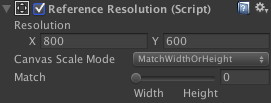Unity 4.6 UI Tip: Canvas Scaler (formerly Reference Resolution)
Posted on 2014-11-04 by marconiusOne of the most common problems when designing user interfaces, especially on mobile platforms, is compatibility with multiple display sizes and aspect ratios. The new Unity UI does allow us to overcome this to some extent by using anchors, but this can lead to unwanted stretching and distortion of images, or simply problematic placement of UI elements when aspect ratio is drastically different. Not setting anchors to stretch, on the other hand, will mean that UI elements maintain their set pixel-size, meaning they will seem very small on a larger display (or very large on a smaller display).

This issue can be solved through the (currently undocumented) Reference Resolution component, attached to our root Canvas, which must be set to Overlay mode. In essence, this component takes Width and Height parameters, then changes the effective pixel size of the Canvas to match these as closely as possible. For example, if you set the parameters to be 800x600 while your actual display is 1600x1200, in the Editor you will still see the size of the Canvas as 800x600 and will be able to design your UI elements accordingly. When the Canvas is set to Overlay mode, its size will follow the size of your Game screen in the editor, so we can easily test various sizes.
This only works if the aspect ratio isn’t changed, however. With different aspect ratios, the Canvas Scale Mode setting comes into play:
- When set to Expand, the shorter of the width/height of the Canvas’s rectangle will be set to be equal to the appropriate parameter; the other one will expand to whatever is required to match the aspect ratio of the screen.
- When set to Shrink, the longer of the width/height of the Canvas’s rectangle will be set to be equal to the appropriate parameter; the other one will shrink to whatever is required to match the aspect ratio of the screen.
- When set to MatchWidthOrHeight, there is an extra parameter, Match; setting this to 0 (Width) will make the width of the Canvas match the parameter and stretch or shrink the height to match the screen’s aspect ratio; setting it to 1 (Height) will do the opposite; setting it to a value between the two will stretch or shrink both sides to some degree.
Instantiate issues
There is a small problem with Reference Resolution: because there is no method in Unity to Instantiate a GameObject from code already as a child of another object, new objects must be made first, then their transform.parent needs to be set. Unfortunately because of the way Canvas objects work, this causes the newly created object to distort, its position, scale or other parameters potentially changing.
The best solution for this issue is to, after setting the parent, reset all parameters of the new object to those of its prefab:
public RectTransform InstantiateUI (RectTransform prefab, Transform parent)
{
GameObject newGameObject = Instantiate (prefab) as GameObject;
newGameObject.transform.parent = parent;
RectTransform newRectTransform = newGameObject.transform as RectTransform;
newRectTransform.anchoredPosition = prefab.anchoredPosition;
newRectTransform.anchorMax = prefab.anchorMax;
newRectTransform.anchorMin = prefab.anchorMin;
newRectTransform.localRotation = prefab.localRotation;
newRectTransform.localScale = prefab.localScale;
newRectTransform.pivot = prefab.pivot;
newRectTransform.sizeDelta = prefab.sizeDelta;
return newRectTransform;
}
Created for Unity 4.6 beta version 20.
This post is meant for advanced users; for basic information on the new UI features, please check the offical tutorial videos!
Update: Unity 4.6 beta version 21 updated the old Reference Resolution component and renamed it Canvas Scaler, merging its functionality with Physical Resolution, now providing multiple Scale Modes; the functionality described above is still the same when set to Scale With Screen Size. The component is now properly documented as well.
The newly added Reference Pixels Per Unit parameter is essentially a simple way to scale imported sprites and has an effect on the Native Size of Images.